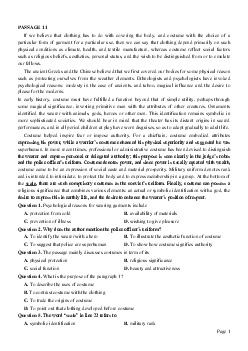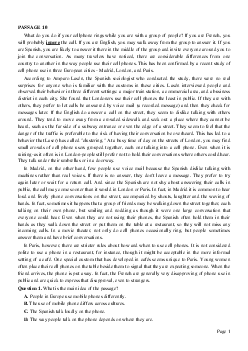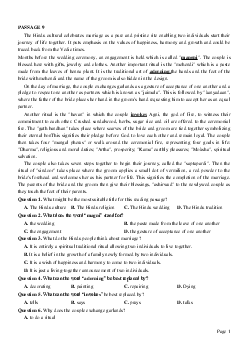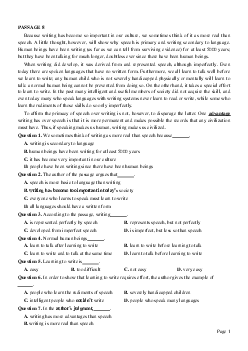



Preview text:
PASSAGE 23
One million of the planet's eight million species are threatened with extinction by humans, scientists
warned Monday in what is described as the most comprehensive assessment of global nature loss ever.
Their report paints a bleak picture of a planet ravaged by an ever-growing human population, whose
insatiable consumption is destroying the natural world.
Shrinking habitat, exploitation of natural resources, climate change and pollution are the main drivers
of species loss and are threatening more than 40% of amphibians, 33% of coral reefs and over a third of
all marine mammals with extinction, according to the report of the Intergovernmental Science-Policy
Platform on Biodiversity and Ecosystem Services (IPBES), a U.N committee. This report comes six
months after the UN Intergovernmental Panel on Climate Change (IPCC) warned that the world has less
than 12 years to avoid catastrophic levels of global warming. In the same way that the IPCC report turned
the climate crisis into a political concern, the authors of the IPBES report hope that it will thrust nature
loss into the global spotlight.
Just as with climate change, humans are the main culprits of biodiversity damage, altering 75% of
Earth's land and 66% of marine ecosystems since pre-industrial times and using more than a third of the
world's land and 75% of freshwater supplies for crop or livestock production, according to the report.
Additionally, it also pointed out that in 2015, a third of marine stocks were being fished at unsustainable
levels and the amount of raw timber being harvested has increased by almost half since 1970, with up to
15% of it cut illegally. Moreover, marine plastic pollution has increased tenfold since 1980. Pollution
entering coastal ecosystems has produced more than 400 ocean "dead zones," totaling an area bigger than
the United Kingdom. These areas are so starved of oxygen they can barely support marine life.
However, "it is not too late to make a difference, but only if we start now at every level from local to
global," said Sir Robert Watson, IPBES chair, adding that this would require a complete change of
economic systems and a shift in political and social mindsets. Several recommendations were, made in
the report, including improving sustainability in farming by planning landscapes so that they provide food
while supporting the species that live there at the same time, reforming supply chains and reducing food
waste. When it comes to healthy oceans, the report recommends effective fishing quotas, designated
protected areas and reducing the pollution that runs off from the land into the sea, among other actions.
(Adapted from https://edition.cnn.com)
Question 1. Which of the following is the passage’s main concern?
A. How governments can save species from extinction.
B. Marine life under threat due to increasing pollution.
C. The impending great loss of biodiversity due to human activities.
D. The negative impacts of climate change on biodiversity.
Question 2. What can be inferred from paragraph 2?
A. A catastrophe will happen in 12 years if global warming continues.
B. Authors of the IPBES report want to increase awareness about nature loss.
C. The IPCC report drew the attention of politicians to the extinction of species.
D. Climate change is the biggest contributor to species loss, according to IPBES.
Question 3. The word “bleak” in paragraph 1 can be best replaced by . A. dangerous B. unpromising C. cruel D. severe Page 1
Question 4. The word “it” in the second paragraph refers to . A. political concern B. IPCC’s report C. IPBES’s report D. climate crisis
Question 5. It can be inferred from the last paragraph that .
A. International agencies are entirely responsible for preventing nature loss.
B. Changing economic systems will lead to a shift in political and social mindsets.
C. Landscapes can be altered in ways that benefit species in the area.
D. By minimizing pollutants from land, polluted oceans can be cleaned up.
Question 6. The word “support” in the fourth paragraph is closest in meaning to . A. assist B. provide C. hold D. sustain
Question 7. Which of the following is TRUE, according to the passage?
A. More than a quarter of Earth’s species are on the verge of extinction.
B. Pollution levels in ocean “dead zones” are far greater than those in the United Kingdom.
C. Humans are to blame for both climate change and loss of biodiversity.
D. Amphibians account for 40% of the species that are under threat.
Question 8. Which of the following statements can be inferred from the passage?
A. Marine life is suffering the greatest impact from human activities.
B. The exploitation of resources is a threat for animals as well as plants.
C. We can only stop biodiversity loss by making farming more sustainable.
D. 75% of Earth’s land was altered as a consequence of industrial activities. ĐÁP ÁN 1-C 2-B 3-B 4-C 5-C 6-A 7-C 8-B
LỜI GIẢI CHI TIẾT Question 1: C
Câu nào sau đây thể hiện ý chính của đoạn văn?
A. Làm thế nào các chính phủ có thể cứu các loài khỏi sự tuyệt chủng.
B. Sinh vật biển bị đe dọa do ô nhiễm ngày càng tăng.
C. Sự mất mát lớn sắp xảy ra của đa dạng sinh học do các hoạt động của con người.
D. Các tác động tiêu cực của biến đổi khí hậu đến đa dạng sinh học.
=> Ngay đoạn 1 đã tập trung giới thiệu về hậu quả của những hoạt động của con người tới đa dạng sinh
học và các đoạn sau đó đưa ra các dẫn chứng cụ thể. Question 2: B
Điều gì có thể được suy ra từ đoạn 2?
A. Một thảm họa sẽ xảy ra trong 12 năm nữa nếu sự nóng lên toàn cầu tiếp diễn.
B. Tác giả của báo cáo IPBES muốn tăng cường nhận thức về mất tự nhiên.
C. Báo cáo của IPCC đã thu hút sự chú ý của các chính trị gia về sự tuyệt chủng của loài.
D. Biến đổi khí hậu là tác nhân lớn nhất dẫn đến mất loài, theo IPBES. Page 2
Dẫn chứng: “In the same way that the IPCC report turned the climate crisis into a political concern, the
authors of the IPBES report hope that it will thrust nature loss into the global spotlight.”
Dịch: Cũng giống như cách báo cáo của IPCC biến cuộc khủng hoảng khí hậu thành mối quan tâm chính
trị, các tác giả của báo cáo IPBES hy vọng rằng nó sẽ đẩy sự mất mát tự nhiên vào tầm ngắm toàn cầu. Question 3: B
Từ "bleak" trong đoạn 1 có thể được thay thế tốt nhất bằng .
A. nguy hiểm B. không hứa hẹn C. tàn nhẫn D. nghiêm trọng
Dẫn chứng: “Their report paints a bleak picture of a planet ravaged by an ever-growing human
population, whose insatiable consumption is destroying the natural world.” Dịch: Báo cáo của họ vẽ ra
một bức tranh ảm đạm về một hành tinh bị tàn phá bởi dân số loài người ngày càng tăng, với mức tiêu
thụ vô độ đang phá hủy thế giới tự nhiên Question 4: C
Từ “it” trong đoạn thứ hai đề cập đến .
A. quan tâm chính trị B. Báo cáo IPCC, C. Báo cáo IPBES, D. khủng hoảng khí hậu Question 5: C
Nó có thể được suy ra từ đoạn cuối là .
A. Các cơ quan quốc tế hoàn toàn chịu trách nhiệm ngăn ngừa mất thiên nhiên.
B. Thay đổi hệ thống kinh tế sẽ dẫn đến sự thay đổi trong tư duy chính trị và xã hội.
C. Phong cảnh có thể được thay đổi theo cách có lợi cho các loài trong khu vực.
D. Bằng cách giảm thiểu các chất ô nhiễm từ đất liền, các đại dương bị ô nhiễm có thể được làm sạch.
Dẫn chứng: Several recommendations were, made in the report, including improving sustainability in
farming by planning landscapes so that they provide food while supporting the species that live there at
the same time, reforming supply chains and reducing food waste Dịch: Một số khuyến nghị đã được đưa
ra trong báo cáo, bao gồm cải thiện tính bền vững trong canh tác bằng cách lập kế hoạch cảnh quan để họ
cung cấp thực phẩm đồng thời hỗ trợ các loài sống ở đó, cải cách chuỗi cung ứng và giảm lãng phí thực phẩm Question 6: A
Từ hỗ trợ từ “support” trong đoạn thứ tư có nghĩa gần nhất với .
A. hỗ trợ B. cung cấp C. giữ D. duy trì
Dẫn chứng: These areas are so starved of oxygen they can barely support marine life
Dịch: Những khu vực này bị thiếu oxy đến nỗi chúng hầu như không thể hỗ trợ sinh vật biển Question 7: C
Điều nào sau đây là ĐÚNG, theo đoạn văn?
A. Hơn một phần tư các loài Trái đất đang trên bờ vực tuyệt chủng.
B. Mức độ ô nhiễm trong các khu vực chết của đại dương, khu vực lớn hơn nhiều so với Vương quốc Anh.
C. Con người phải chịu trách nhiệm cho cả biến đổi khí hậu và mất đa dạng sinh học.
D. Động vật lưỡng cư chiếm 40% số loài đang bị đe dọa. Dẫn chứng đầu đoạn 3: “Just as with climate
change, humans are the main culprits of biodiversity damage” Dịch: Cũng giống như biến đổi khí hậu,
con người là thủ phạm chính gây thiệt hại đa dạng sinh học Page 3 Question 8: B
Phát biểu nào sau đây có thể được suy ra từ đoạn văn?
A. Sinh vật biển đang chịu tác động lớn nhất từ các hoạt động của con người.
B. Việc khai thác tài nguyên là mối đe dọa đối với động vật cũng như thực vật.
C. Chúng ta chỉ có thể ngăn chặn mất đa dạng sinh học bằng cách làm cho nông nghiệp bền vững hơn.
D. 75% đất Earth Trái đất bị thay đổi do hậu quả của các hoạt động công nghiệp.
Dẫn chứng đoạn 1 paragraph 3: “Just as with climate change, humans are the main culprits of
biodiversity damage, altering 75% of Earth's land and 66% of marine ecosystems since pre-industrial
times and using more than a third of the world's land and 75% of freshwater supplies for crop or livestock
production, according to the report.” Dịch: Cũng giống như biến đổi khí hậu, con người là thủ phạm
chính gây thiệt hại đa dạng sinh học, làm thay đổi 75% đất đai của Trái đất và 66% hệ sinh thái biển kể từ
thời tiền công nghiệp và sử dụng hơn một phần ba đất đai của thế giới và 75% nguồn cung cấp nước ngọt
cho sản xuất trồng trọt hoặc chăn nuôi, theo báo cáo. Page 4




